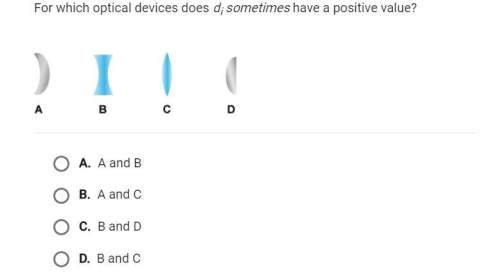
Physics, 24.04.2020 21:55, aesthetickait
There are 2 charged particles, A and B. You know that particle A is positively charged. When you place particle B next to particle A, then particle B starts moving away from particle A. What does this mean for particle B?

Answers: 1
Other questions on the subject: Physics

Physics, 21.06.2019 23:00, alanisalvarez2000
Follow these directions and answer the questions. 1. set up the ripple tank as in previous investigations. 2. bend the rubber tube to form a "concave mirror" and place in the ripple tank. the water level must be below the top of the hose. 3. generate a few straight pulses with the dowel and observe the reflected waves. do the waves focus (come together) upon reflection? can you locate the place where the waves meet? 4. touch the water surface where the waves converged. what happens to the reflected wave? 5. move your finger twice that distance from the hose (2f = c of c, center of the curvature) and touch the water again. does the image (the reflected wave) appear in the same location (c of c)? you may have to experiment before you find the exact location. sometimes it is hard to visualize with the ripple tank because the waves move so quickly. likewise, it is impossible to "see" light waves because they have such small wavelengths and move at the speed of light. however, both are examples of transverse waves and behave in the same way when a parallel wave fronts hit a curved surface.
Answers: 1

Physics, 22.06.2019 06:40, miaglory3828
Light traveling in a medium with a refractive index 1.19 is incident on a plate of another medium with index of refraction 1.79. at what angle of incidence is the reflected light fully polarized?
Answers: 2


Physics, 22.06.2019 13:40, crayons18
An ideal otto cycle has a compression ratio of 10.5, takes in air at 90 kpa and 40°c, and is repeated 2500 times per minute. using constant specific heats at room temperature, determine the thermal efficiency of this cycle and the rate of heat input if the cycle is to produce 90 kw of power.
Answers: 2
Do you know the correct answer?
There are 2 charged particles, A and B. You know that particle A is positively charged. When you pla...
Questions in other subjects:

Physics, 17.12.2020 02:20

Mathematics, 17.12.2020 02:20

Mathematics, 17.12.2020 02:20



Mathematics, 17.12.2020 02:20

Geography, 17.12.2020 02:20

English, 17.12.2020 02:20


Mathematics, 17.12.2020 02:20







